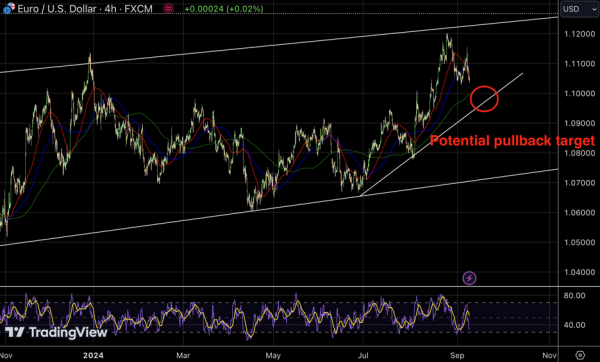USD Gains Momentum as Mixed US Jobs Data and Eurozone Weakness Shape Forex Sentiment
The forex market started the week with a notable downward move in the EUR/USD pair, falling below the 1.1050 mark during the New York session. This decline is largely driven by the aftermath of a mixed US Nonfarm Payrolls report for August. While fewer jobs were added than expected, the US labor market showed resilience with a drop in the unemployment rate and wage growth outpacing forecasts. These mixed signals have left traders recalibrating their expectations for Federal Reserve rate cuts:

The US Dollar Index (DXY), a key barometer of the Greenback’s value against six major global currencies, surged to near 101.50, indicating robust demand for the USD. Market participants had initially hoped that weaker labor data might prompt the Fed to adopt a more aggressive stance on rate cuts, particularly amid growing signs of slowing economic growth. However, with wage growth remaining strong and unemployment dropping, it’s clear that inflationary pressures haven’t subsided entirely, forcing the Fed into a more cautious approach.
This balancing act by the Fed—attempting to tame inflation while avoiding an economic recession—has left investors in a state of uncertainty. The current outlook suggests that while rate cuts are possible, the magnitude of these cuts may be smaller than anticipated. According to the interest rate futures, the probability of a 50-basis-point (bps) rate cut in September has fallen to just 27%, while a more modest 25-bps cut remains the prevailing expectation.
This hesitation by the Fed to move aggressively on rate cuts has been a positive catalyst for the US Dollar. As long as the Fed maintains its measured approach, favoring smaller cuts, the USD is likely to retain its strength, particularly against the Euro.
On the European side, the EUR/USD weakness is further compounded by investor focus on the European Central Bank’s upcoming policy meeting. The ECB is widely expected to cut its key interest rates by another 25 bps, marking its second dovish move in the current easing cycle. With Eurozone inflation slowing and economic growth faltering, particularly in Germany, the case for continued rate cuts has become stronger.
In August, the Eurozone’s Harmonized Index of Consumer Prices dropped to 2.2%, its lowest level in over two years. This signals a significant containment of price pressures, providing the ECB with the room to continue its easing policies. The Eurozone economy, led by Germany, is showing signs of significant weakness. Germany, the region’s largest economy, has already entered a technical recession, with second-quarter GDP shrinking and third-quarter prospects looking equally grim.
This poor economic outlook has taken a toll on investor sentiment, as reflected in the latest Eurozone Investor Confidence report, which deteriorated to -15.4 in September. The further decline in confidence points to a lack of optimism surrounding the region’s growth prospects, especially with the German economy continuing to underperform. As long as economic conditions remain sluggish and inflation is under control, the ECB will likely continue its easing path, adding further pressure on the Euro.
For the Euro, all eyes will be on the ECB’s policy decision this Thursday. While another rate cut appears to be a foregone conclusion, the tone of ECB policymakers will be key in determining the Euro’s near-term direction. Any signs of further easing measures or concern about the Eurozone’s economic outlook could push the EUR/USD pair even lower, particularly if the Fed maintains a relatively hawkish stance.